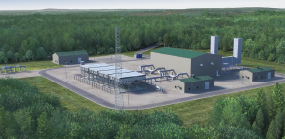The electric power industry is preparing for a rise in customer demand and major urban load centers are requiring more electricty. As electric demand in urban areas rises, congrestion on the electric transmission system may increase. This study found that gas-fueled generation has the potential to increase electric generating capacity while easing congrestion on the transmission system. Congestion and bottlenecks on the electric transmission system often occur as a result of the need to transmit electricty from distant generating units to urban load centers. Constructing natural gas generating units within the constrained area could relieve many bottleenecks on the interstate eletric transmission network.
Major urban load centers in New England, the coastal Mid-Atlantic states, the east central region around the Great Lakes, as well as Florida, Texas and other parts of the South, portions of California and the Southwest are vulnerable to transmission constraints and capacity shortages. While there is evidence of transmission system congestion, only a small amount of new transmission is planned through 2007. Environmental requirements, public concerns and uncertainty caused by electric industry restructuring make it difficult for companies to justify expenditures for new transmission facilities. There are approximately 150,000 miles of transmission above 230 kilovolts (kV) in the United States. Only 6,600 miles of new transmission above 230 kV are planned over the next 10 years, representing a 4 percent increase. There also is evidence of capacity shortages. In parts of the U.S. generating capacity margins have fallen below typical historical levels, and data from the North American Electric Reliability Council (NERC) indicate that generation reserve margins in many of NERC’s 10 reliability regions will fall below historical levels by 2007.
NERC forecasts that generating capacity will expand by approximately 9 1,000 MW by 2007, which is an increase of about 12 percent. Nearly all of the increased electric generating capacity will be fueled by natural gas. NERC projects that natural gas will fuel 62,900 MW, or 69 percent, of net generation additions through 2007. This represents an increase in gas use for electric generation from 3.3 trillion cubic feet (Tcf) in 1998 to nearly 4.4 Tcf in 2007, with a growth rate of 3 percent per year (Table 1.1). Natural gas-fired capacity (including dual-fuel capacity) currently accounts for about 147,000 MW out of total summer generating capacity of 721,000 MW.
In spite of the significant generating capacity additions already planned, there likely will be shortfalls in generation capacity resources over the next 10 years because of rising electricity demand. Figure 1-1 summarizes the potential shortfalls that could occur by 2007 for each NERC region based on maintaining current capacity margins. The shortfall reflects the difference between capacity required in each region to maintain capacity margins at present levels, and planned capacity additions.
New gas-fired combined cycle units can be built in or near load centers experiencing capacity problems and transmission constraints. Thus, new, high efficiency gas-fueled generators could account for a greater portion of planned capacity than has been specified in the NERC forecast. This study found that the total potential for natural gas-fueled generating capacity ranges from approximately 97,000 MW to 143,000 MW (Table 1.2). A very large proportion of this capacity probably will be installed in or near major load centers where it will help to ease transmission constraints.
The cumulative impact of electric power generation requirements on gas demand will be signficant. While NERC projects an increase in gas demand to 4.4 Tcf by 2007, the Energy Information Administration (EM) forecasts that gas demand for electric generation will grow to 5.7 Tcf by 2007.
Natural gas-fueled generation is uniquely suited to meet growing electricity demand. The compact size, environmental benefits and quick construction times make gas-fired combined cycle units ideal candidates for electric generation needs. Further, natural gas pipelines already serve many of these markets, while pipeline companies are targeting other potential markets for capacity expansions. Unlike the electric transmission system, the gas transmission system is approaching full integration and therefore is capable of providing gas transportation service to a wide range of gas markets.



